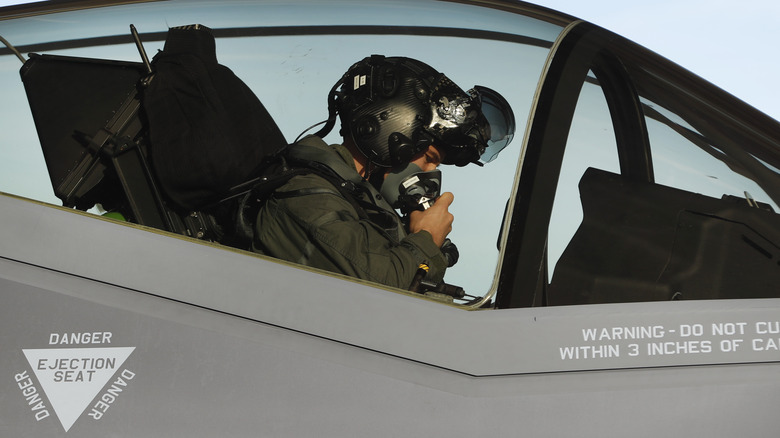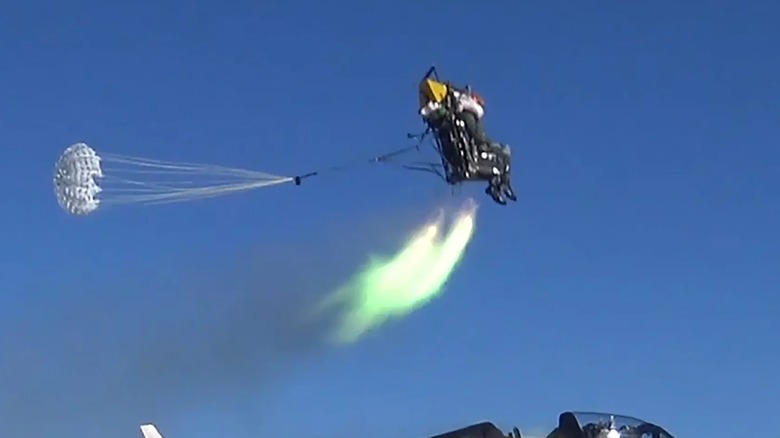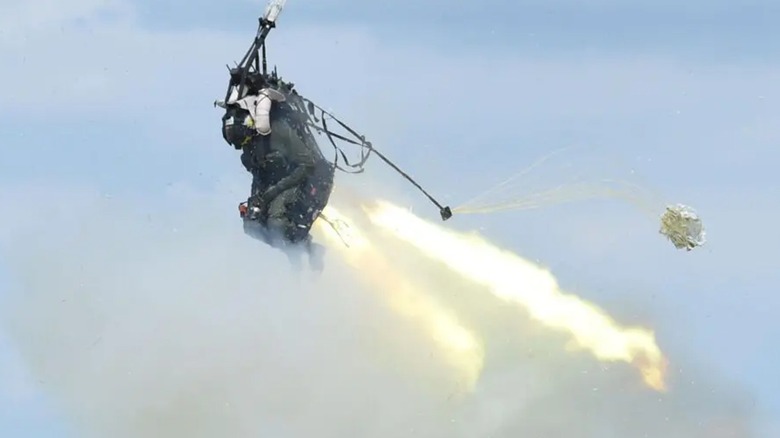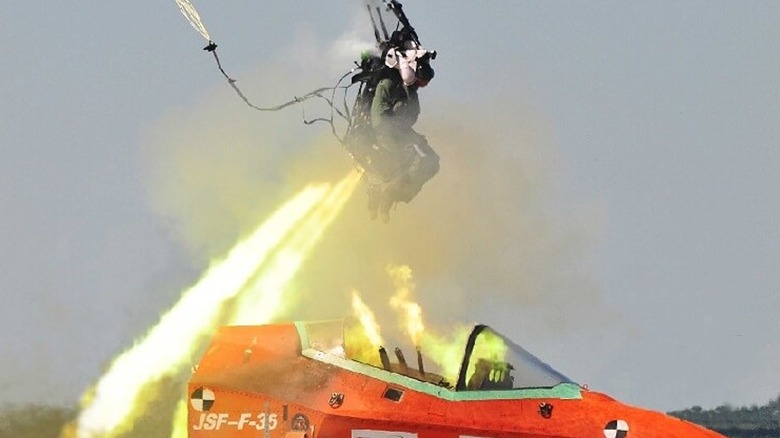Here's What Makes The F-35 Ejection Seat So Unique
People have been flying planes for over a century, and they've had the benefit of airplane ejection seats since World War II. Every aircraft with an ejection seat uses a unique system designed for that particular plane, which is the case for the F-35 Lightning II. The F-35 is the most advanced fighter jet in the world, and it's packed with impressive capabilities. One of those capabilities is speed, as the F-35 can fly about the planet at Mach 1.6 (1,228 mph).
That's an important characteristic because, when it comes to ejecting from an aircraft, speed matters. The movies make ejection look fairly simple; a pilot pulls a handle, the canopy blasts off, and a rocket shoots them and their seat far from the plane. What the movies don't often show is how damaging that is to the person in the ejection seat. Bailing from an aircraft careening through the sky at hundreds of miles per hour isn't easy and puts tremendous strain on the human body.
Many pilots sustain injuries from their ejection, and it's caused by the forces involved. The F-35's ejection seat is no exception, as it's rated to fire a pilot away from the jet at incredible speeds, putting as much as 25 gs of force upon a person's body. That's a punishment few can survive, much less walk away from, but the impressive features and design of the F-35's ejection seat make walking away possible — not to mention, it beats going down with a crashing plane.
What makes the F-35's ejection seat so unique
The F-35B can hover, and it is the only aircraft fitted with an auto-eject system, which could be a game-changer in saving lives, as Martin-Baker's US16E is the first ejection seat capable of an auto-ejection. The reason it's installed on the F-35B is due to its ability to perform a short takeoff and vertical landing (STOVL). Because problems can arise on the ground or in the air, the ejection seat can be used at any time. The US16E is given the term "zero-zero," as it relates to hovering because the ejection can occur when the jet is at zero altitude and moving at zero speed.
The system takes variables into account before activating, and in 2022, it potentially saved a pilot's life when their F-35 nosedived from a low-altitude hover. It's undetermined whether the pilot manually ejected, but it's likely the auto-eject initiated when it was safe to do so, as you can see in the video:
The ejection system worked flawlessly, but you may wonder why it activated at all when the plane was on the ground and mostly immobile. During hovering, if any major parts fail, the aircraft will pitch violently — faster than a pilot can react. The auto-eject feature kicks in before the human brain has time to realize what's happening. Other ejection seats like Collins Aerospace's ACES 2 on the F-15 or the ACES 5 on the F-22 save lives just like the US16E, but they lack the ability to auto-eject, making the F-35's ejection system truly unique.
The US16E Ejection Seat installed on the F-35 Lightning II
The F-35's unique ejection seat system is designed and produced by Martin-Baker for the U.S. Military. The seat is designated US16E, and it's installed on all variants of the F-35 at a cost upwards of $120,000 each. According to the manufacturer's website, the US16E includes performance parameters that take into account terrain clearance, physiological loading limits, the pilot's mass, and more to ensure the pilot escapes the craft and makes it to the ground as safely as possible.
There have been several accidents requiring the use of the US16E by F-35 pilots, and Martin-Baker notes that the system has saved nine lives as of late 2024. The company also produced over 1,200 ejection seats, which were delivered to Lockheed Martin, which produces the F-35. The seat's technical specs are impressive, as it boasts an operating ceiling of 50,000 feet; it comes with a seat survival kit, an oxygen supply, and an automatically deployed life raft should the pilot eject over water.
Martin-Baker had some production problems with its seats, requiring the grounding of F-35s while the issue was sorted out. The problem was related to the explosive components used to launch the seat out of the cockpit. The system, Seat Cartridge Actuated Device (CAD), was found and fixed in a number of aircraft identified with the problem, which impacted multiple fighters that used CADs in their ejection seat systems. Fortunately, nobody was hurt, and the issue was fixed.
How does the ejection seat on an F-35 work?
The aircraft's auto-eject feature initiates entirely outside the control of the pilot, but they can still manually activate their ejection. For manual deployment of the F-35's ejection seat, a pilot must make the decision to eject and pull the lever. This begins a series of events that happen in very short order of only a few seconds. The first thing that happens involves the canopy, which doesn't blast off; it fractures and splits down the middle, creating a path for ejection, which is a unique feature of the F-35.
Cartridges installed into the seat detonate, separating the ejection system and pilot from the aircraft. Simultaneously, a rocket motor located beneath the seat fires as the pilot's legs retract and their harnesses tighten to hold them into place. The rocket propels the pilot and seat a few hundred feet away from their aircraft. Ejecting when the canopy isn't facing upward can be deadly, depending on the distance to the ground and other factors.
Once cleared from the aircraft, the seat's parachute deploys to slow the descent. Parachute deployment is tied to altitude, and the system determines whether to deploy it immediately or to wait until a better altitude can be reached. The pilot is then separated from the seat and drops safely to the ground or water, beginning their survival phase. The seat includes gear they may need to survive in a hostile or austere environment until rescue.



